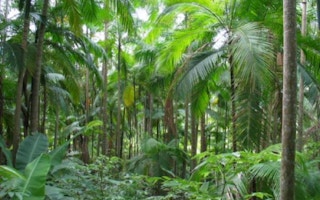Why should the government agencies and other organizations search for a reforestation program from other countries when there is already a system in the Philippines proven to be viable and sustainable?
The Davao-based Mindanao Baptist Rural Life Center (MBRLC) Foundation, Inc. has developed a scheme that combines farming and reforestation together. “We have been doing the system since the late 1980s but it didn’t catch the attention of the government and funding agencies,” says Roy C. Alimoane, the first Filipino director of the center.
Alimoane is referring to the Sustainable Agroforest Land Technology (SALT 3), a modification of the original Sloping Agricultural Land Technology (SALT 1). There are two more types of the system: Simple Agro-Livestock Technology (SALT 2) and Small Agrofruit Livelihood Technology (SALT).
All these systems are considered as agroforestry, a collective name for all land-use systems and practices where woody perennials and crops are planted together in the same area.
“The principle of SALT is the same as that used by the Ifugao tribes,” explains Alimoane. “But instead of using rocks as wall, we are utilizing natural barriers, particularly nitrogen-fixing trees and shrubs.”
In SALT system, double hedgerows of nitrogen-fixing trees and shrubs are planted at 4-5 meters intervals on equal-elevation contours. The hedgerows are pruned frequently (every 5-6 weeks when moisture is adequate) and the prunings are applied to the crops as mulch and as source of fertilizer.
In the space between the hedgerows, a combination of permanent, semi-permanent, and annual crops are planted. “We are doing this so as to rebuild the ecosystem and maximize yields while enabling farmers to organize their work time efficiently,” says Alimoane.
The hedgerows serve also as a block against soil erosion. “Soil erosion is an enemy to any nation – far worse than any outside enemy coming into a country and conquering it because it is an enemy you cannot see vividly,” said Harold R. Watson, former MBRLC director who received the 1985 Ramon Magsaysay Award for peace and international understanding. “It’s a slow creeping enemy that soon possesses the land.”
Some years ago, the Department of Environment and Natural Resources (DENR) reported that 22 provinces in the country had an “alarming” soil erosion rate. Batangas and Cebu reportedly had lost 80-85 percent of their topsoil to erosion.
“Without soil, there would be no food apart from what the rivers and the sea can provide,” reminded Edouard Saouma when he was still director-general of the UN Food and Agriculture Organization. “The soil is the world’s most precious natural resource. Yet it is not valued as it should be. Gold, oil, minerals and precious stones command prices which have led us to treat soil as mere dirt.”
A 10-year study conducted at the MBRLC farm showed that a farm tilled in the traditional manner erodes at the rate of 1,163.4 metric tons per hectare per year. A SALT farm erodes at the rate of only 20.2 metric tons per hectare per year in the same period.
Aside from soil erosion, another problem that farmers face is deforestation. “Strip away the trees, and the soil is totally exposed to the full force of rain,” said Watson, who retired in the mid-1990s.
When Portuguese navigator Ferdinand Magellan “rediscovered” the Philippines in 1521, the Philippines was teemed with virgin forests. But when Ferdinand Marcos became the president, mountains were devoid of trees and became denuded.
“As the timber boom gained momentum, the government was unable to supervise concessions effectively or enforce logging regulations,” wrote Robert Repetto, author of The Forest for the Trees? Government Policies and the Misuse of Forest Resources. “Links between timber companies and politicians further eroded government control.”
In a privilege speech when he was still a member of the Senate, Orlando Mercado deplored: “Every hour, the country loses 20 hectares of forest blanket.”
Logging, whether legal or illegal, denuded the country’s forests. “The attitude of loggers in the Philippines has always been: get the trees before someone else does,” wrote environmental journalist Alan C. Robles. “This attitude puts a premium on short-term profits, but its effect is long-term irreversible environmental damage like decreased soil fertility, loss of groundwater and extended dry seasons.
To save what remains of the country’s forest cover, the MBRLC developed SALT 3. In a two-hectare lot, one hectare is to food production following the SALT system. “This is the source of income for the farmers while waiting for the trees to grow and mature,” says Alimoane.
The other hectare is planted to different trees like mangium, narra, acacia, and other timber trees. While the trees are still young, the ground can be planted to various crops like mung beans, ginger, sweet potato, and taro. Once the trees are tall enough, rattan is planted below the trees.
“The system is suited for small farmers,” says Alimoane. “We think if this system is largely promoted, we might be able to reforest the country again. But we cannot do it alone. We need support from every citizen of this country.”
Business author A. Lou Vickery once said: “Nothing average ever stood as a monument to progress. When progress is looking for a partner, it doesn’t turn to those who believe they are only average. It turns instead to those who are forever searching and striving to become the best they possibly can. If we seek the average level we cannot hope to achieve a high level of success. Our only hope is to avoid being a failure.”
SALT 3 is one hope the Philippines should adapt now – before it’s too late. “When a nation loses the capability to feed, clothe, and shelter itself, it loses the capability to chart its own destiny,” Watson reminded.

















